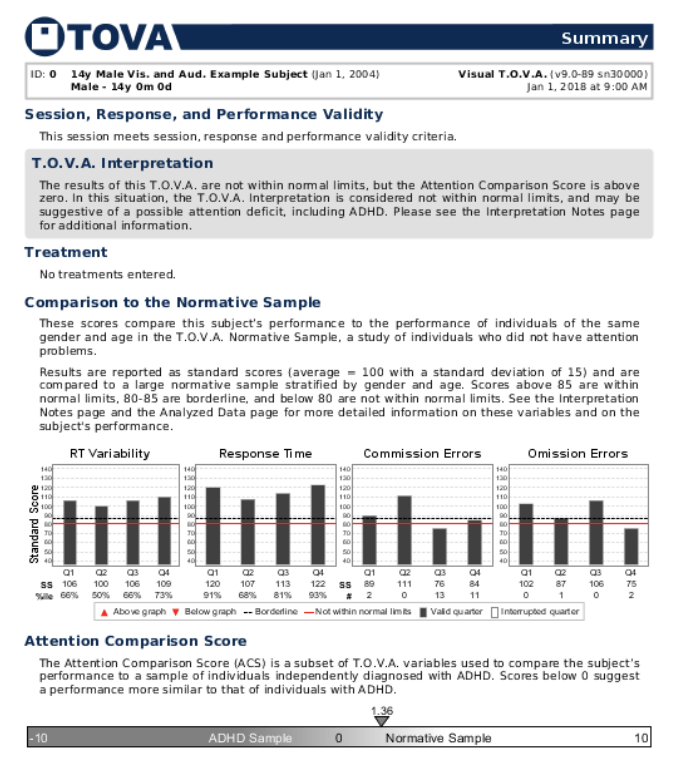The T.O.V.A. accurately and precisely measures key variables of both auditory and visual information processing.
The T.O.V.A. is a culture- and language-free, sufficiently long computerized test that requires no left/right discrimination or sequencing. Responses to visual or auditory stimuli are recorded with a unique, highly accurate (±1 ms) microswitch.
The T.O.V.A. calculates response time variability (consistency), response time (speed), commissions (impulsivity), and omissions (focus and vigilance). These calculations are then compared to a large age- and gender-matched normative sample, as well as to a sample population of individuals independently diagnosed with ADHD. These comparison results are used to create an immediately available, easy-to-read report.

Taking the T.O.V.A. Test
It’s quite simple: the visual test flashes stimuli on the screen (or the auditory test beeps stimuli on speakers), and the subject taking the test responds as quickly and as accurately as they can with a small handheld microswitch.
Both the auditory and visual tests are 21.6 minutes long. (A shorter 10.8-minute visual T.O.V.A. test is administered to subjects ages 4 to 5.5.)
The visual test has two simple images that alternately flash on the screen, and the subject presses the button after the correct square. The auditory test has two tones, and the subject presses the button after the higher tone.
The T.O.V.A. takes the subject’s responses and compares them to a normative study. This allows us to figure out where the subject’s responses fall on the ‘bell curve’ of within normal limits.
The T.O.V.A. also compares the subject’s responses to a study of people diagnosed with ADHD. These comparisons are not diagnoses! No test can diagnose ADHD. Only a clinician can do that. T.O.V.A. results should only be interpreted by qualified professionals.
T.O.V.A. Test Instructions
(English version)
Watch this short video to see how the T.O.V.A. test is taken.
Test Credits
After you finish a T.O.V.A. test, you must have a T.O.V.A. test credit to retrieve the test results from the T.O.V.A. device (the black box) and save them to your T.O.V.A. database.
Once those results are saved to your database, the data is permanently removed from the T.O.V.A. device and is stored on the computer that administered the test. You can view, export, or print the T.O.V.A. test results in your database as often as you like.

T.O.V.A. Reports
Reports are categorized by the subject’s age and the specific test administered. We offer four types of reports based on age groups:
- Visual Preschool (ages 4 to 5.5),
- Visual School-Age (ages 5.5 to 17),
- Visual Adult (ages 18 to 80+), and
- Auditory (ages 6 to 29).
The T.O.V.A. Interpretation, the conclusion of the report, provides a summary of the results based on 29 independently calculated scores. These scores are shown in the Comparison to the Normative Sample and in the Attention Comparison Score.
These two comparisons help provide an understanding of the subject’s performance in both low arousal and high arousal conditions.
The T.O.V.A. measures four main variables of attention and inhibitory control:
1. Response Time Variability
2. Response Time
3. Commissions
Commission Errors occur when the subject incorrectly responds to a nontarget, and are a measure of inhibitory control, or self control, an important factor in decision making, healthy relationships and focused attention.
4. Omissions
Omission Errors occur when the subject does not respond to a target, and are a measure of focus, sustained attention and/or distractibility due to hyperactivity or wandering attention.
Want even more information?
To learn more about the T.O.V.A., attend one of our workshops on Attention, ADHD, and the T.O.V.A. Our workshops have been described as “informative,” “fun,” and “practice-changing.”